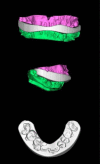Current trends in orthognathic surgery
- PMID: 34974683
- PMCID: PMC8721433
- DOI: 10.7181/acfs.2021.00598
Current trends in orthognathic surgery
Abstract
Orthognathic surgery has steadily evolved, gradually expanding its scope of application beyond its original purpose of simply correcting malocclusion and the facial profile. For instance, it is now used to treat obstructive sleep apnea and to achieve purely cosmetic outcomes. Recent developments in three-dimensional digital technology are being utilized throughout the entire process of orthognathic surgery, from establishing a surgical plan to printing the surgical splint. These processes have made it possible to perform more sophisticated surgery. The goal of this review article is to introduce current trends in the field of orthognathic surgery and controversies that are under active discussion. The role of a plastic surgeon is not limited to performing orthognathic surgery itself, but also encompasses deep involvement throughout the entire process, including the set-up of surgical occlusion and overall surgical planning. The authors summarize various aspects in the field of orthognathic surgery with the hope of providing helpful information both for plastic surgeons and orthodontists who are interested in orthognathic surgery.
Keywords: Cleft surgery; Facial asymmetry; Jaw surgery; Malocclusion; Obstructive sleep apnea; Orthognathic surgery.
Conflict of interest statement
No potential conflict of interest relevant to this article was reported.
Figures




References
-
- Wu RT, Wilson AT, Gary CS, Steinbacher DM. Complete reoperation in orthognathic surgery. Plast Reconstr Surg. 2019;143:1053e–1059e. - PubMed
-
- Naran S, Steinbacher DM, Taylor JA. Current concepts in orthognathic surgery. Plast Reconstr Surg. 2018;141:925e–936e. - PubMed
-
- Rosen HM. Evolution of a surgical philosophy in orthognathic surgery. Plast Reconstr Surg. 2017;139:978–90. - PubMed
-
- Steinhauser EW. Historical development of orthognathic surgery. J Craniomaxillofac Surg. 1996;24:195–204. - PubMed
-
- Bell RB. A history of orthognathic surgery in North America. J Oral Maxillofac Surg. 2018;76:2466–81. - PubMed
LinkOut - more resources
Full Text Sources

